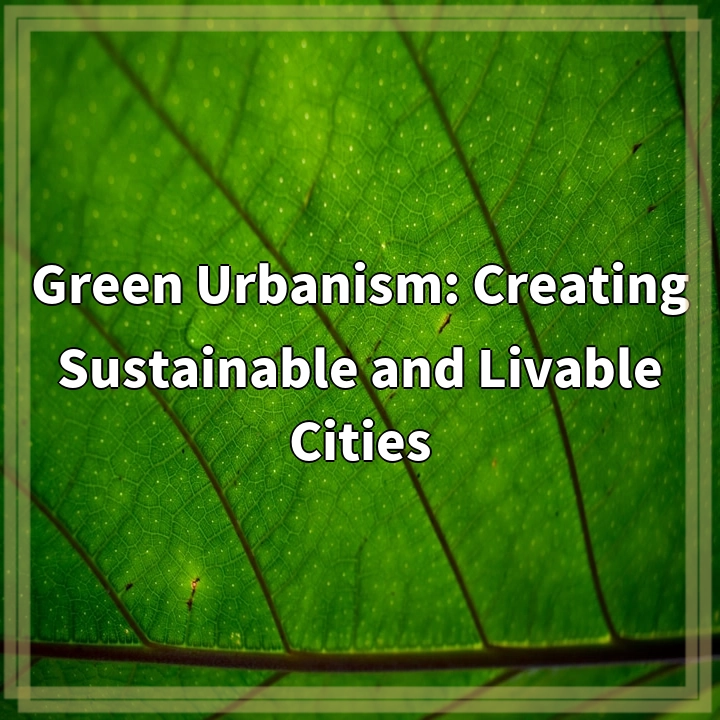Physical Address
304 North Cardinal St.
Dorchester Center, MA 02124
Physical Address
304 North Cardinal St.
Dorchester Center, MA 02124

Green urbanism is a concept that aims to create sustainable and livable cities by integrating environmental, social, and economic principles into urban planning and development. It involves designing cities in a way that minimizes environmental impacts, conserves resources, and promotes the well-being of residents.
1. Limited Space and Increased Urban Density
One of the challenges of implementing green urbanism is dealing with limited space and increased urban density. As cities grow, there is a higher demand for housing and infrastructure, leading to the conversion of green spaces and potential loss of biodiversity. Finding innovative ways to accommodate this growth while preserving natural areas is crucial for sustainable urban development.
2. Transportation and Mobility
Transportation is another significant aspect to consider in green urbanism. Increasing car dependency can result in air pollution, traffic congestion, and a lack of public spaces. Implementing sustainable transportation solutions like promoting public transit, walking, and cycling infrastructure can help reduce carbon emissions and improve the quality of urban life.
3. Limited Access to Green Spaces
Inadequate access to green spaces is a common problem in cities. Lack of parks and green areas can lead to physical and mental health issues, such as obesity and stress. Green urbanism aims to address this problem by incorporating green spaces, urban parks, and community gardens into urban planning to enhance the well-being of residents and improve overall quality of life.
4. Environmental Degradation and Pollution
Urbanization often accompanies environmental degradation and pollution. Ill-planned and unregulated urban development can lead to deforestation, soil erosion, water pollution, and air pollution. Green urbanism emphasizes sustainable practices, such as green infrastructure, energy-efficient buildings, and waste management systems, to minimize environmental impacts and promote a healthier urban environment.
5. Social Equity and Inclusivity
Creating sustainable and livable cities involves addressing social equity and inclusivity. Urban development projects should strive to provide equal access to essential services, such as affordable housing, healthcare, education, and public transportation, to all residents, regardless of their socioeconomic status. Green urbanism seeks to promote inclusive and equitable cities that provide opportunities for all.
Green urbanism offers various solutions to address the real-world problems associated with urban development. By implementing these solutions, cities can become more sustainable, livable, and environmentally friendly.
1. Sustainable Urban Planning
An important solution is to prioritize sustainable urban planning. This involves considering factors such as land use, infrastructure, and building design to minimize the environmental footprint of cities. By incorporating green spaces, preserving natural areas, and promoting compact and efficient development, cities can create a more sustainable future.
2. Sustainable Transportation
To combat challenges related to transportation and mobility, promoting sustainable transportation options is key. Cities can invest in public transit systems, develop cycling and pedestrian infrastructure, and encourage carpooling to reduce traffic congestion and air pollution. By prioritizing alternative modes of transportation, cities can improve mobility and reduce greenhouse gas emissions.
3. Accessible Green Spaces
Cities can prioritize the creation and maintenance of accessible green spaces. By integrating parks, community gardens, and rooftop gardens, cities can provide residents with opportunities for recreation, relaxation, and improved well-being. Accessible green spaces also contribute to overall urban resilience and biodiversity conservation.
4. Sustainable Infrastructure
Green urbanism advocates for the development of sustainable infrastructure. This includes implementing energy-efficient buildings, utilizing renewable energy sources, and improving waste management systems. By incorporating green technologies and practices, cities can minimize their environmental impact and contribute to a healthier urban environment.
5. Focus on Social Equity
Addressing social equity and inclusivity is vital in sustainable urban development. Cities must prioritize affordable housing, access to healthcare, education, and essential services for all residents. By reducing disparities and ensuring equal access to resources, cities can foster a more inclusive and equitable society.
Overall, green urbanism offers holistic and integrated solutions to the challenges faced by urban areas. By implementing these solutions, cities can mitigate environmental impacts, enhance quality of life, and create a sustainable future for generations to come.
Green Urbanism
If you’re wondering where the article came from!
#